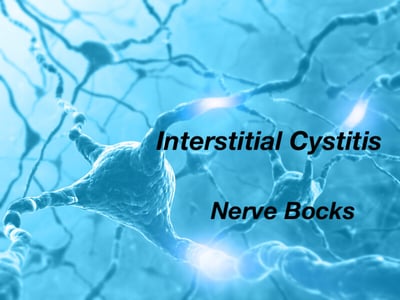 Patients who suffer from bladder pain syndrome/interstitial cystitis (BPS/IC) face many challenges. One of the primary issues is chronic pelvic pain, which can range from mild to severe.
Patients who suffer from bladder pain syndrome/interstitial cystitis (BPS/IC) face many challenges. One of the primary issues is chronic pelvic pain, which can range from mild to severe.
Other symptoms of BPS/IC include frequent urination (especially at night), a persistent urge to urinate, and pain during intercourse. Patients may also experience urinary urgency and frequency, urinary incontinence, and difficulty emptying the bladder.
So how do patients find relief from these complex issues? The causes of BPS/IC remain uncertain, and there's no known cure. The good news is that there are several promising treatment options, including interstitial cystitis nerve blocks.
BPS/IC Treatments
The most common treatments for BPS/IC include behavioral changes, medications, physical therapy, and bladder distention. Lifestyle changes like avoiding certain foods and drinks, drinking more water, exercising regularly, and reducing stress can help manage symptoms.
Physical therapy, such as pelvic floor exercises and biofeedback, can help improve bladder control and reduce pelvic pain. Bladder distention is an in-office procedure where a small balloon is inserted into the bladder to stretch the muscles and reduce pain. Certain medications such as antispasmodics, tricyclic antidepressants, and nerve blockscan also be used to reduce pain.
Nerve Blocks
Nerve blocks work by blocking the transmission of pain signals to the brain. These treatments involve the injection of a local anesthetic into a specific area, numbing nearby nerves to prevent them from sending pain signals. Nerve blocks can be used to reduce pain and inflammation in a specific area of the body and may provide long-term relief from chronic pain.
BPS/IC Nerve Block Studies From 2022
Multiple studies from late 2022 examined the efficacy of nerve blocks to treat BPS/IC. One, published in , tracked 47 women who were treated with a series of roughly-yearly bladder injections over at least 10 years.
This study was promising not only because it seemed to relieve symptoms but also because it appeared safe. There were no severe adverse events, patients didn't experience tolerance buildups that would have required more injections or higher doses, and the impacts seemed to last longer than predicted.
Another study, published in BJUI Compass, examined 84 patients who had been referred to an outpatient pelvic rehab center after receiving a BPS/IC diagnosis from a urologist.
At first, these patients tried pelvic floor physical therapy. When they failed to see positive results after six weeks, they were administered pelvic floor trigger point injections – shots that target painful, highly sensitive knots in muscle tissue. They also received nerve block shots.
This research analyzed how much pelvic pain the patients were experiencing before and three months after treatment along with their bladder functionality. It found that men and women aged 22 to 86 experienced significant improvements in pain and functionality. According to the researchers, this backs the idea that outpatient treatments targeting pelvic floor pain and inflammation may be valid options for helping patients overcome urinary urgency, frequency, and burning as well as chronic discomfort.
Both of these studies had their limitations, however. For instance, both were conducted on small sample sizes. While the Toxin study was a long-term assessment, its authors admitted that such research is sorely lacking.
The Outlook
Unfortunately, there is no cure for BPS/IC. However, with the right combination of therapies, patients can manage their symptoms and improve their quality of life.
The heart of the challenge may ultimately lie in determining which combination is "right." For instance, people who undergo botulinum injection therapies may quit because they don't feel the outcome is worth the discomfort, which is also a problem with other invasive alternatives. Interstitial cystitis nerve blocks may also fail in some patient populations: Since the root causes of BPS/IC are still unknown, it's hard to definitively say whether these treatments will be appropriate in all cases.
Dependable diagnostic processes will undoubtedly play an essential role in effective BPS/IC mitigation going forward. By clarifying what's going on – and distinguishing similar-symptom conditions like urge incontinence from the urinary issues experienced by BPS/IC patients, urologists can hopefully choose treatments that are better targeted to individual patients. For instance, high-fidelity urodynamics testing can reveal how well the bladder and other organs retain and release fluid in real-time. Such techniques provide caregivers with enhanced insight into when and how the muscles contract, which is key to deciding whether injections are a good fit.


